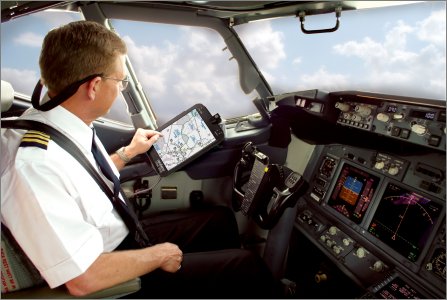Lufthansa Systems selected to supply touchscreen Class 2 electronic flight bags
Virgin Atlantic Airways has chosen Lufthansa Systems to supply Class 2 electronic flight bags (EFB) for its aircraft fleet, marking the first step in the carrier’s plan to roll out technology upgrades across its cockpit, cabin, engineering and ground operations.
The UK long-haul carrier has expanded to the point at which “back office demands start to grow disproportionately”, says Virgin director of flight operations Matt Lee. He adds that, as part of preparations for the arrival of the Airbus A380 in late 2008, Virgin looked at how it could apply advances being introduced on the ultra-large airliner across its in-service A340 and Boeing 747 fleets.
|
| Virgin's EFB will use a NavAero touch screen (pictured in a Boeing 737) |
“We are very aware of what direction the industry is moving in general and we didn’t want to get left behind as our fleet grows,” says Lee. “What we didn’t want to do was wait for the A380 to come along and then have to begin this process.”
Under the deal with Lufthansa Systems, 13 747-400s, five A340-300s and 22 A340-600s will be equipped with hard-mounted NavAero t·Bag C2² touchscreen EFBs, initially running software identical to that already deployed by German carrier Lufthansa for its laptop-based Class 1 EFBs.
Virgin electronic flight solutions programme manager Mark Snelgrove says the airline opted for a Class 2 EFB rather than a fully integrated Class 3 device because of lower installation costs and the ability to use a common system across its Airbus and Boeing types. Installation of the NavAero hardware takes about a day and a half.
Virgin – which alongside FedEx Express and World Airways becomes one of the first airlines to opt for a Class 2 EFB – plans to begin flight tests by the end of this year with at least three aircraft, and complete the roll-out across all 40 aircraft by the end of 2007, subject to UK Civil Aviation Authority approval.
Initially, the aircraft will carry “electronic flight folders” encompassing flightplans, notams, weather charts and manuals. Phase two would enable the EFB to be used for take-off performance calculations and to draw Arinc 429 data from aircraft systems, such as the flight management computer. The third and final phase would introduce electronic charts.
“We conservatively believe it will save us £5 million [$8.7 million] in the first five years,” says Lee. Virgin expects to reduce the weight of paper on each aircraft by 75% to 15-20kg (30-45lb), as documents such as the quick-reference handbook are likely to “always remain in paper format”, says Lee.
ANDREW DOYLE / LONDON
Source: Flight International




















